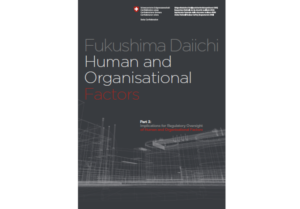Lessons Learned from the Fukushima Analysis for Oversight in the Field of Human and Organisational Factors
Since 11 March 2011, ENSI has been addressing the lessons learned from the Fukushima Daiichi reactor accident. To mark the tenth anniversary, ENSI is publishing a further report, and considering its regulatory approaches and methods in respect of human and organisational factors.
Following the reactor accident at the Fukushima Daiichi nuclear power plant on 11 March 2011, ENSI has been analysing the events and their consequences from various points of view in the Fukushima reports. Among other aspects of the accident, ENSI has focused on the human and organisational factors. In the first report relating to this area, ENSI considered the organisations that were involved in managing the events; in the second report it considered the course of the accident from the viewpoint of the people directly involved at the site of the accident.
Now ENSI is publishing the follow-up report ‘Oversight Implications in the Area of Human and Organisational Factors’. The report is based, among other things, on shortcomings identified in the oversight approach as a result of the reactor accident analysis and on the finding that a strong safety culture is important not only for nuclear plant operators, but also for the regulatory authority itself. Ultimately, the safety culture of the regulator has an influence on that of the nuclear plants.
In this Fukushima report, ENSI considers its approaches and methods in the oversight area of human and organisational factors. It includes the latest findings from the safety sciences, where, for example, the systemic approach is discussed. According to this approach, nuclear installations are recognised as complex systems in which the interplay of interacting Human, Technology and Organisation factors form so-called HTO systems.
The principle of continuous improvement
From a systemic point of view, a management system is required in nuclear installations, in which the continuous improvement of the interaction of human, technology and organisation factors is of utmost importance. In its oversight, the Human and Organisational Factors (HOF) Section of ENSI checks whether and how the systemic approach is taken into account by the regulated parties.
In turn, the way in which oversight is conducted can strengthen, or, in the worst case, weaken, the responsibility of the regulated parties and affect dynamics that can influence the safety of the installations.
Self-examination and dialogue with the regulated parties
The Fukushima Daiichi accident followed the course it did because, among other things, there was insufficient awareness of the possibility of unexpected serious events, notably tsunamis, both on the part of the operator but also on the part of the regulators. The structures in Japan also led to inadequate safety precautions. Even if accidents are optimally prepared for from a technical and organisational aspect, in view of the high hazard potential of nuclear installations, both operators and regulators must always be able to anticipate and manage unexpected, i.e., very rare, events. The associated technical term for this is the ‘resilient organisation’. Underlying this is a safety concept referred to as ‘Safety-II’.
Alongside the established ‘learning from errors’ (‘Safety-I’ approach), the ‘Safety-II’ concept assumes that safety is also strengthened when learning based on correctly functioning practices and procedures occurs. The HOF Section has also derived a few tips from the safety management of the civil aviation sector that it can apply to its own regulatory role as well as developing specific regulatory approaches and methods: at the core here is a dialogue with the regulated parties that promotes self-reflection.
In addition, the HOF Section has adopted the report ‘Oversight Implications in the Area of Human and Organisational Factors’ as a starting point for the further development of its own regulatory activity.
Decision making in emergency situations
The report also addresses the abilities and characteristics needed for decision making in emergency situations when conditions of uncertainty, time pressure and stress prevail. Both the competencies of individuals and teams as well as technical and organisational factors influence decisions. Therefore, their interaction is likewise the subject of the ongoing oversight of the HOF Section.


